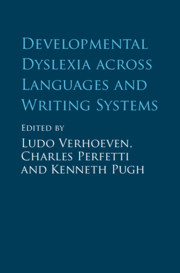Book contents
- Developmental Dyslexia across Languages and Writing Systems
- Developmental Dyslexia across Languages and Writing Systems
- Copyright page
- Contents
- Figures
- Tables
- Contributors
- 1 Introduction
- Part I Developmental Dyslexia across Languages and Writing Systems
- Part II Cross-Linguistic Perspectives on Developmental Dyslexia
- 11 Behavioral Precursors of Developmental Dyslexia
- 12 Neural Predictors of Developmental Dyslexia
- 13 Neurocognitive Markers of Developmental Dyslexia
- 14 Role of Visual Attention in Developmental Dyslexia
- 15 Morphological and Semantic Processing in Developmental Dyslexia
- 16 Modeling the Variability of Developmental Dyslexia
- 17 Modeling Developmental Dyslexia across Languages and Writing Systems
- 18 Etiology of Developmental Dyslexia
- 19 Intergenerational Transmission in Developmental Dyslexia
- Epilogue
- Index
- References
14 - Role of Visual Attention in Developmental Dyslexia
from Part II - Cross-Linguistic Perspectives on Developmental Dyslexia
Published online by Cambridge University Press: 27 September 2019
- Developmental Dyslexia across Languages and Writing Systems
- Developmental Dyslexia across Languages and Writing Systems
- Copyright page
- Contents
- Figures
- Tables
- Contributors
- 1 Introduction
- Part I Developmental Dyslexia across Languages and Writing Systems
- Part II Cross-Linguistic Perspectives on Developmental Dyslexia
- 11 Behavioral Precursors of Developmental Dyslexia
- 12 Neural Predictors of Developmental Dyslexia
- 13 Neurocognitive Markers of Developmental Dyslexia
- 14 Role of Visual Attention in Developmental Dyslexia
- 15 Morphological and Semantic Processing in Developmental Dyslexia
- 16 Modeling the Variability of Developmental Dyslexia
- 17 Modeling Developmental Dyslexia across Languages and Writing Systems
- 18 Etiology of Developmental Dyslexia
- 19 Intergenerational Transmission in Developmental Dyslexia
- Epilogue
- Index
- References
Summary
Attention is a neurocognitive process composed by subprocesses located in several brain areas and controlled by specific neurotransmitters (Petersen & Posner, 2012). This process aims to select relevant information and modulates sensory processing, perception, memory, and learning. This selection of information processing – based on the combination of perceptual noise exclusion and signal enhancement – is fundamental in developing fine object representations in the brain (see Corbetta & Shulman, 2011; Petersen & Posner, 2012; Roelfsema, van Ooyen, & Watanabe, 2010, for reviews).
Alerting and orienting are the two main processes involved in reading acquisition. Alerting is defined as the multisensory attentional process that increases performance during tasks (Petersen & Posner, 2012), producing a phasic change in alertness (e.g., Ronconi et al., 2016). The alerting system can already be measured in the infant brain (e.g., Ronconi, Facoetti et al., 2014).
- Type
- Chapter
- Information
- Developmental Dyslexia across Languages and Writing Systems , pp. 307 - 326Publisher: Cambridge University PressPrint publication year: 2019
References
- 7
- Cited by



